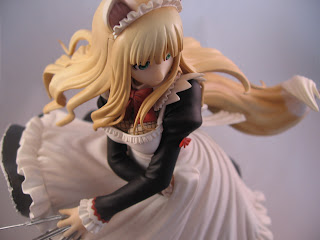Released in late February 2012, Rouna is the sixth figure released by Kotobukiya from the JRPG Shining Hearts, with character creation by the one and only Tony Taka. Coming in at a very generous 1/8 scale, Rouna measures 10" tall with her fixed base and requires about six inches of shelf space as a non-castoffable, no-assembly-required piece. She is depicted in a long black maid's uniform with actual fabric for her stockings and the covering of her decolletage.
 | ||
| Original illustration from Tony Taka. Thanks to konachan.com for the image. |
Rouna is an attendant to the game world's Princess Rufina, to be released in figure form in late April, and one can see she scratches a lot of otaku itches, between her honey blonde hair, kemonomimi and tail and her maid uniform. I had a lot of difficulty photographing Rouna in an effort to get her to match the pose in Tony's work, but ultimately I understood that for once in my life it was not my fault. It is not difficult to pick out several significant differences between the original illo and her figure form, which I personally find quite disappointing.
 |
| Rouna enters her surprise birthday party. |
The sculptor seems to offer Rouna a bit more modesty than Tony did, as her chest is covered more, and her skirt is not hiked up nearly as high. Also, the figure presents Rouna with a bit more thickness, more sturdiness to her frame--compare the hipline and torso of the figure compared to the original illustration, and the thickness of her leg. To say that the figure is reasonably proportioned compared to the fantasy-girl measurements that Tony presents would be fair, but not necessarily what people pay the price of admission for.
On the figure, the weight and heft of Rouna's dress and apron seem to be a bit more realistically presented, again to the general demerit of the piece itself. Look at that illustration--the flow of the fabric suggests a strong, confident, active move to hike up her hem. On the figure, it seems like the sculptor imagined Rouna reacting to a surprise attack, like she was caught flatfooted and did not gather enough of her skirt to access the knives she stores in the loops of her garter.
 |
| Impractical? Yes. Sexy? Yes also. |
Rouna is somewhat plain from the back--again, the heaviness of her dress seems to be in play here as it hangs somewhat flatly behind her despite the hiking up in front. Her long, foxy tail is incorporated nicely in the back. Her tail itself I find somewhat disappointing--as a whole it just seems too blunt and lacking texture and volume, especially when compared to the furry frayed end depicted in the original illustration. There are two majorly noticeable seams in the figure; first, where the crown of her head and her ears meet her headband, and down the sides of her head; second, the mold for the tail features a pronounced seam--the sculptor tried to incorporate it into the flow of the tail, and as such it doesn't show up quite as horribly black like the worst seams do, but it is quite obvious where the two halves of the mold came together for the piece. Observe:
 |
| This couldn't have been on the bottom of the tail where no one would see it? Really? |
Perhaps the most egregious of this figure's faults lies with the paint job applied to the hem of Rouna's uniform. Observe the original illustration, where there's a clear, crisp end to the black dress, with a ruffled white underlayer. How--HOW--does that turn into this hot mess?
 |
| This would get you kicked off of Project Runway. |
Not a great one, though. I just can't shake the feeling that, ultimately, I would much rather have the girl in the illustration on my shelf than the one I've got.
はい
- Fishnet fabric for stockings
- Heavy build; feels like a quality piece
- Paint accuracy around hem of dress is a disaster
- Expression & body language defy original illustration
- Placement of seam on tail begs to be noticed








No comments:
Post a Comment